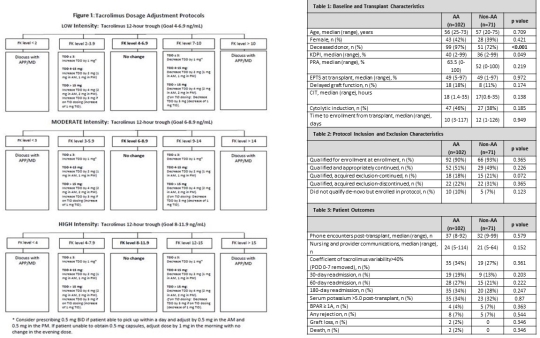Does One Size Fit All? Implementing a Protocolized Ambulatory Tacrolimus Dosing Strategy in a Predominantly African American Renal Transplant Population
Medical University of South Carolina, Charleston, SC.
Meeting: 2018 American Transplant Congress
Abstract number: C79
Keywords: African-American, Dosage, FK506, Kidney transplantation
Session Information
Session Name: Poster Session C: Kidney Immunosuppression: Novel Regimens and Drug Minimization
Session Type: Poster Session
Date: Monday, June 4, 2018
Session Time: 6:00pm-7:00pm
 Presentation Time: 6:00pm-7:00pm
Presentation Time: 6:00pm-7:00pm
Location: Hall 4EF
Introduction: African American (AA) KTx recipients have significant tacrolimus (FK) inter patient variability making protocolized dosage adjustment challenging. We sought to evaluate the efficacy & implementation of a RN driven FK dosing protocol in a predominantly AA KTx population.
Methods: This was a retrospective cohort review of adult KTx recipients between 8/2016 & 6/2017 managed by a FK dosing protocol (figure 1). Simultaneous non-KTx recipients were excluded. Subjects were followed for a max of 10 encounters after enrollment. The primary outcome was coefficient of FK variability (CV) > 40% observed after the first week of Tx. Secondary outcomes included: appropriate inclusion in the protocol; defined as meeting protocol inclusion criteria, & inappropriate was defined as not meeting baseline inclusion criteria or acquiring a factor which would require provider oversight for management. Appropriate dosage adjustment was defined as per protocol adjustment based on manual chart abstraction.
Results: 173 subjects were included. Baseline characteristics were similar between groups, except receipt of a deceased donor (Table 1). The rate of FK CV > 40% observed after the first week of Tx between groups was not significant; AA 34% vs Non-AA 27%, p=0.361. Dosing adjustments were per protocol 80% of the time in the non-AA group vs 78% in the AA-group. Despite this being a RN driven protocol, providers facilitated the majority of dosage adjustments (73% in the AA group & 66% in the non-AA group). There were no differences in pt or graft outcomes (Table 3).
Conclusion: This analysis demonstrates that a FK dosing adjustment protocol provides reliable dose adjustment response to serum FK blood concentrations even in AA recipients. Although this protocol was mainly applied by providers, our data demonstrates that RNs could also apply the protocol regardless of patient race with acceptable patient outcomes. Future observations are needed to confirm these results. 
CITATION INFORMATION: Gylten L., Mardis C., Taber D., Meadows H., Perez C., Elmaasarani Z., Fleming J., Patel N., Baliga P., Rao V., Rohan V., Pilch N. Does One Size Fit All? Implementing a Protocolized Ambulatory Tacrolimus Dosing Strategy in a Predominantly African American Renal Transplant Population Am J Transplant. 2017;17 (suppl 3).
To cite this abstract in AMA style:
Gylten L, Mardis C, Taber D, Meadows H, Perez C, Elmaasarani Z, Fleming J, Patel N, Baliga P, Rao V, Rohan V, Pilch N. Does One Size Fit All? Implementing a Protocolized Ambulatory Tacrolimus Dosing Strategy in a Predominantly African American Renal Transplant Population [abstract]. https://atcmeetingabstracts.com/abstract/does-one-size-fit-all-implementing-a-protocolized-ambulatory-tacrolimus-dosing-strategy-in-a-predominantly-african-american-renal-transplant-population/. Accessed January 2, 2026.« Back to 2018 American Transplant Congress
